Impact of Stigma on Mental Health in England Workplaces: A Review
VerifiedAdded on 2023/06/11
|38
|11488
|58
Literature Review
AI Summary
This narrative literature review explores the pervasive issue of stigma and discrimination faced by individuals aged 25-40 with mental health problems in the workplace in England. It highlights how societal stigma and prejudicial attitudes contribute to low rates of disclosure, employment inequities, and social isolation among affected individuals. The review delves into the stereotypes surrounding mental illness, the impact on access to mental health services, and the various forms of discrimination experienced by employees, including direct and indirect discrimination. It also examines government strategies and supported employment initiatives aimed at addressing these challenges, ultimately emphasizing the need for greater awareness, understanding, and support for mental health in the workplace. Desklib offers a wealth of resources, including similar solved assignments and past papers, to aid students in their studies.
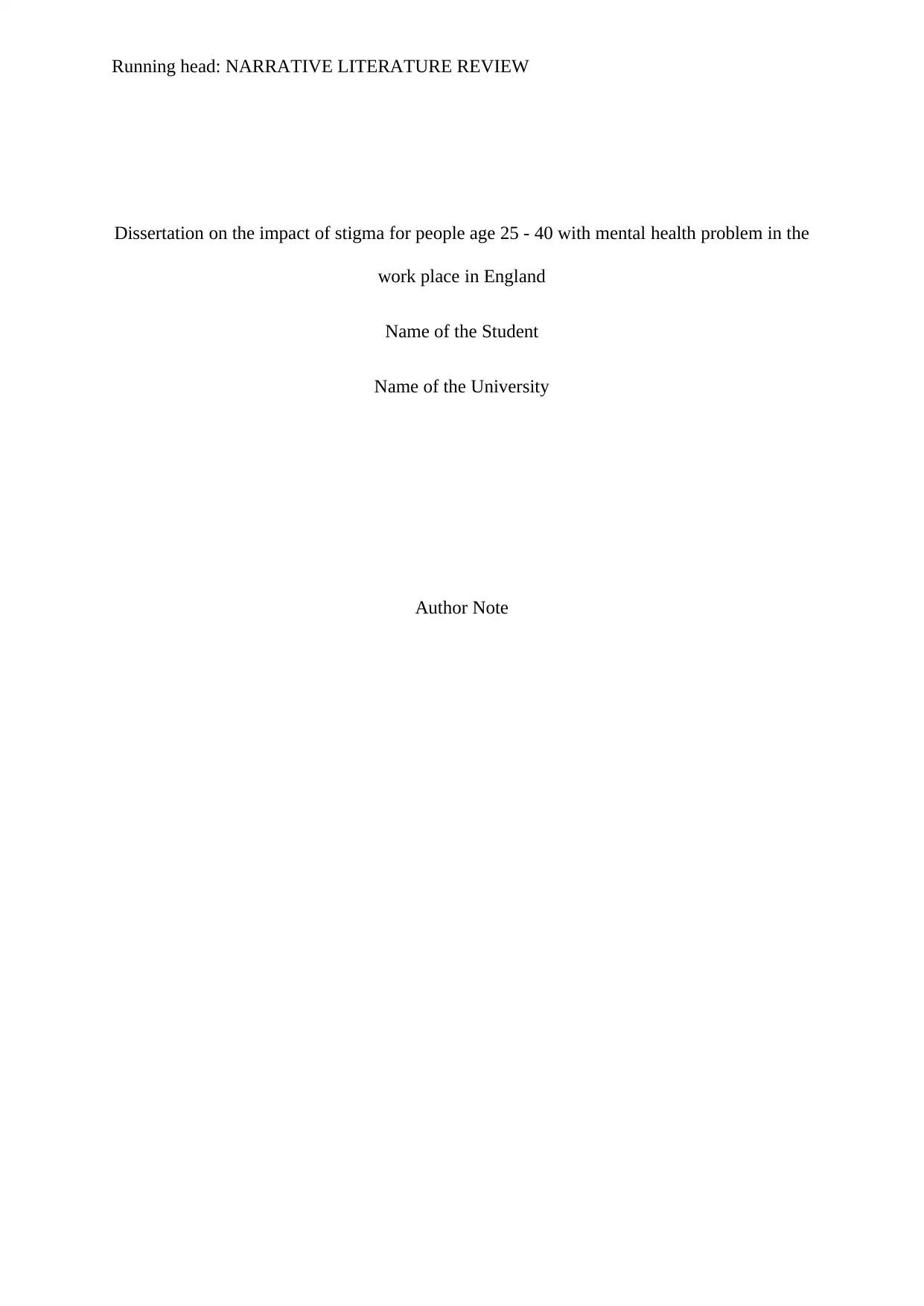
Running head: NARRATIVE LITERATURE REVIEW
Dissertation on the impact of stigma for people age 25 - 40 with mental health problem in the
work place in England
Name of the Student
Name of the University
Author Note
Dissertation on the impact of stigma for people age 25 - 40 with mental health problem in the
work place in England
Name of the Student
Name of the University
Author Note
Paraphrase This Document
Need a fresh take? Get an instant paraphrase of this document with our AI Paraphraser
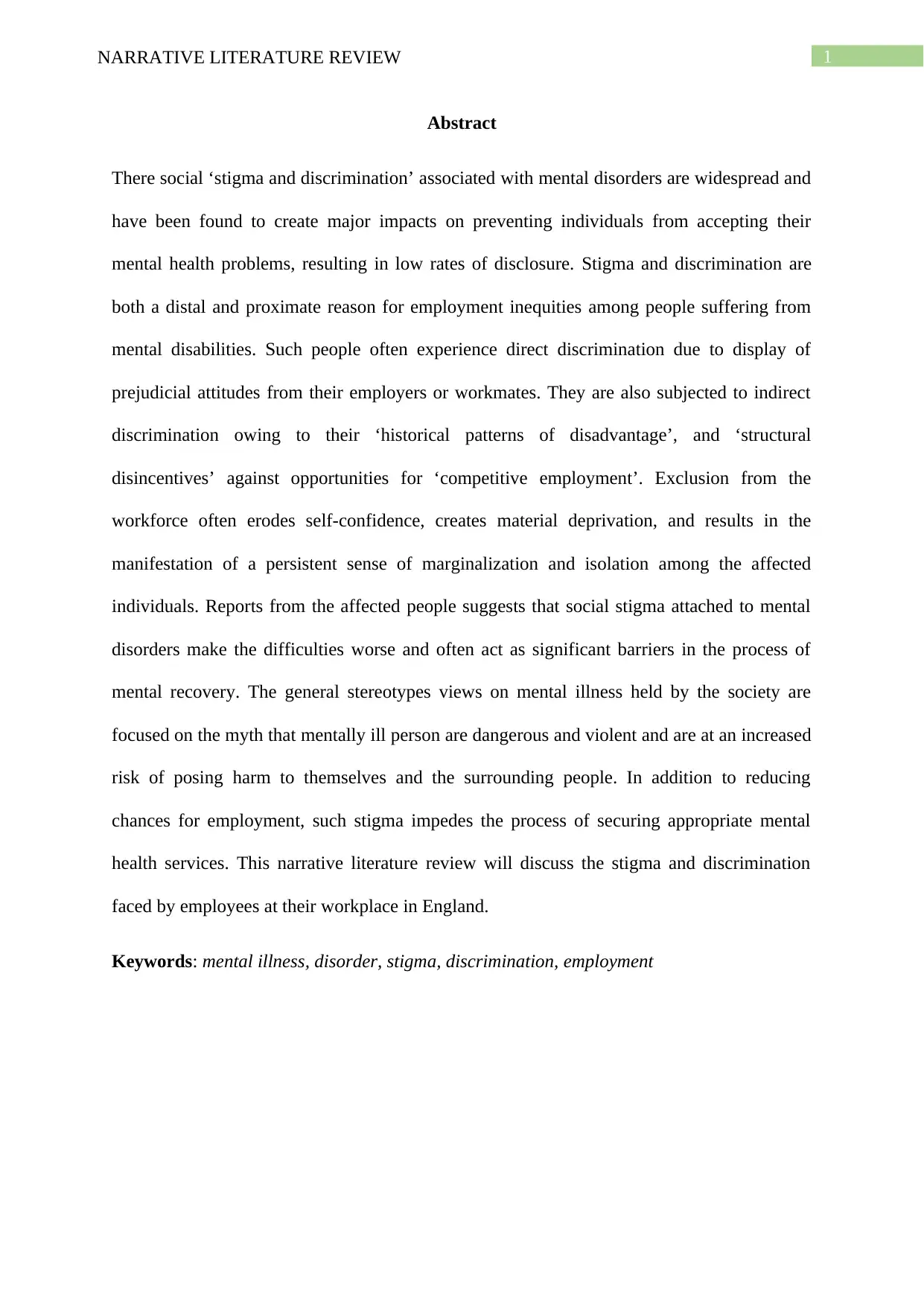
1NARRATIVE LITERATURE REVIEW
Abstract
There social ‘stigma and discrimination’ associated with mental disorders are widespread and
have been found to create major impacts on preventing individuals from accepting their
mental health problems, resulting in low rates of disclosure. Stigma and discrimination are
both a distal and proximate reason for employment inequities among people suffering from
mental disabilities. Such people often experience direct discrimination due to display of
prejudicial attitudes from their employers or workmates. They are also subjected to indirect
discrimination owing to their ‘historical patterns of disadvantage’, and ‘structural
disincentives’ against opportunities for ‘competitive employment’. Exclusion from the
workforce often erodes self-confidence, creates material deprivation, and results in the
manifestation of a persistent sense of marginalization and isolation among the affected
individuals. Reports from the affected people suggests that social stigma attached to mental
disorders make the difficulties worse and often act as significant barriers in the process of
mental recovery. The general stereotypes views on mental illness held by the society are
focused on the myth that mentally ill person are dangerous and violent and are at an increased
risk of posing harm to themselves and the surrounding people. In addition to reducing
chances for employment, such stigma impedes the process of securing appropriate mental
health services. This narrative literature review will discuss the stigma and discrimination
faced by employees at their workplace in England.
Keywords: mental illness, disorder, stigma, discrimination, employment
Abstract
There social ‘stigma and discrimination’ associated with mental disorders are widespread and
have been found to create major impacts on preventing individuals from accepting their
mental health problems, resulting in low rates of disclosure. Stigma and discrimination are
both a distal and proximate reason for employment inequities among people suffering from
mental disabilities. Such people often experience direct discrimination due to display of
prejudicial attitudes from their employers or workmates. They are also subjected to indirect
discrimination owing to their ‘historical patterns of disadvantage’, and ‘structural
disincentives’ against opportunities for ‘competitive employment’. Exclusion from the
workforce often erodes self-confidence, creates material deprivation, and results in the
manifestation of a persistent sense of marginalization and isolation among the affected
individuals. Reports from the affected people suggests that social stigma attached to mental
disorders make the difficulties worse and often act as significant barriers in the process of
mental recovery. The general stereotypes views on mental illness held by the society are
focused on the myth that mentally ill person are dangerous and violent and are at an increased
risk of posing harm to themselves and the surrounding people. In addition to reducing
chances for employment, such stigma impedes the process of securing appropriate mental
health services. This narrative literature review will discuss the stigma and discrimination
faced by employees at their workplace in England.
Keywords: mental illness, disorder, stigma, discrimination, employment
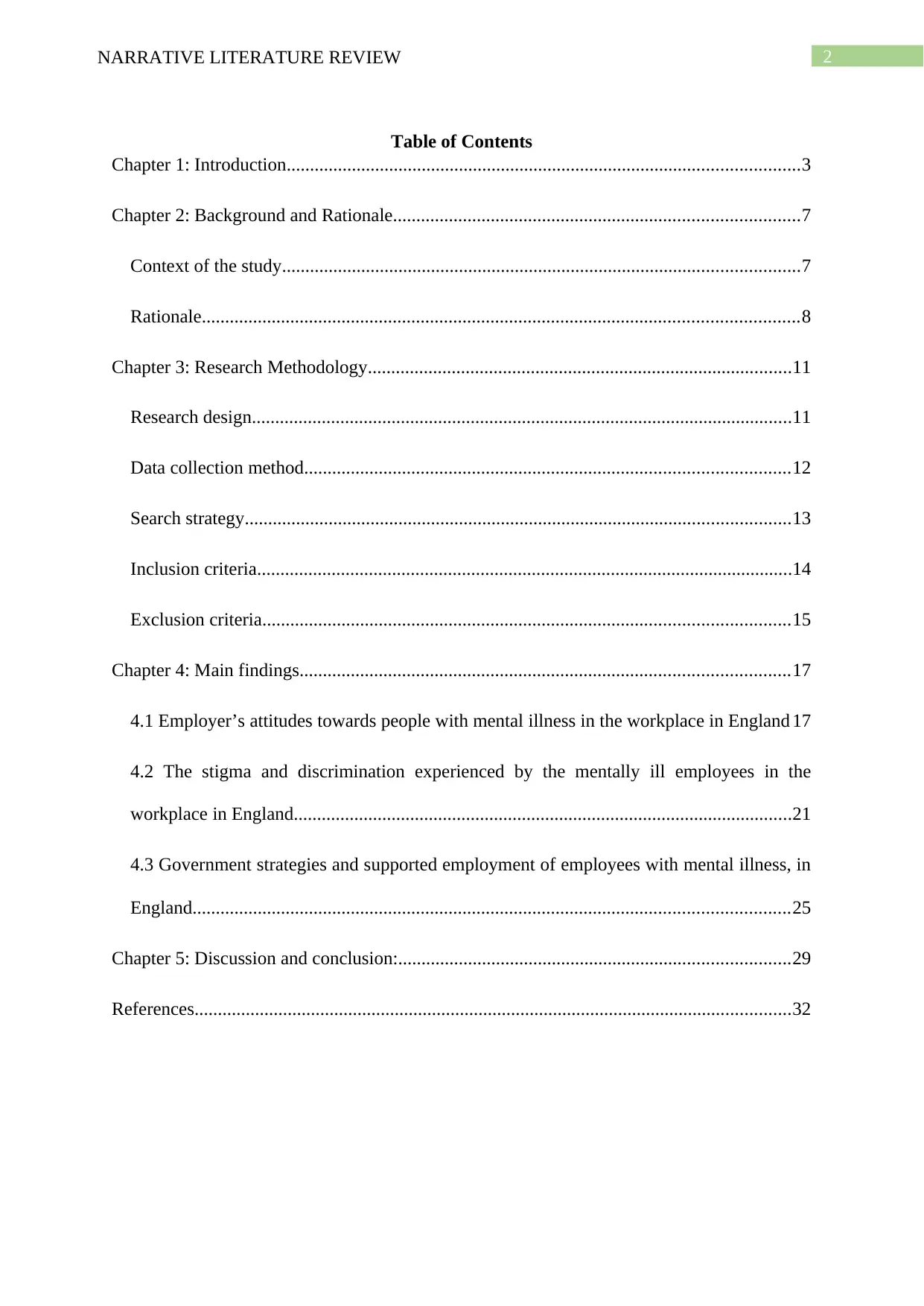
2NARRATIVE LITERATURE REVIEW
Table of Contents
Chapter 1: Introduction..............................................................................................................3
Chapter 2: Background and Rationale.......................................................................................7
Context of the study...............................................................................................................7
Rationale................................................................................................................................8
Chapter 3: Research Methodology...........................................................................................11
Research design....................................................................................................................11
Data collection method........................................................................................................12
Search strategy.....................................................................................................................13
Inclusion criteria...................................................................................................................14
Exclusion criteria.................................................................................................................15
Chapter 4: Main findings.........................................................................................................17
4.1 Employer’s attitudes towards people with mental illness in the workplace in England 17
4.2 The stigma and discrimination experienced by the mentally ill employees in the
workplace in England...........................................................................................................21
4.3 Government strategies and supported employment of employees with mental illness, in
England................................................................................................................................25
Chapter 5: Discussion and conclusion:....................................................................................29
References................................................................................................................................32
Table of Contents
Chapter 1: Introduction..............................................................................................................3
Chapter 2: Background and Rationale.......................................................................................7
Context of the study...............................................................................................................7
Rationale................................................................................................................................8
Chapter 3: Research Methodology...........................................................................................11
Research design....................................................................................................................11
Data collection method........................................................................................................12
Search strategy.....................................................................................................................13
Inclusion criteria...................................................................................................................14
Exclusion criteria.................................................................................................................15
Chapter 4: Main findings.........................................................................................................17
4.1 Employer’s attitudes towards people with mental illness in the workplace in England 17
4.2 The stigma and discrimination experienced by the mentally ill employees in the
workplace in England...........................................................................................................21
4.3 Government strategies and supported employment of employees with mental illness, in
England................................................................................................................................25
Chapter 5: Discussion and conclusion:....................................................................................29
References................................................................................................................................32
⊘ This is a preview!⊘
Do you want full access?
Subscribe today to unlock all pages.

Trusted by 1+ million students worldwide
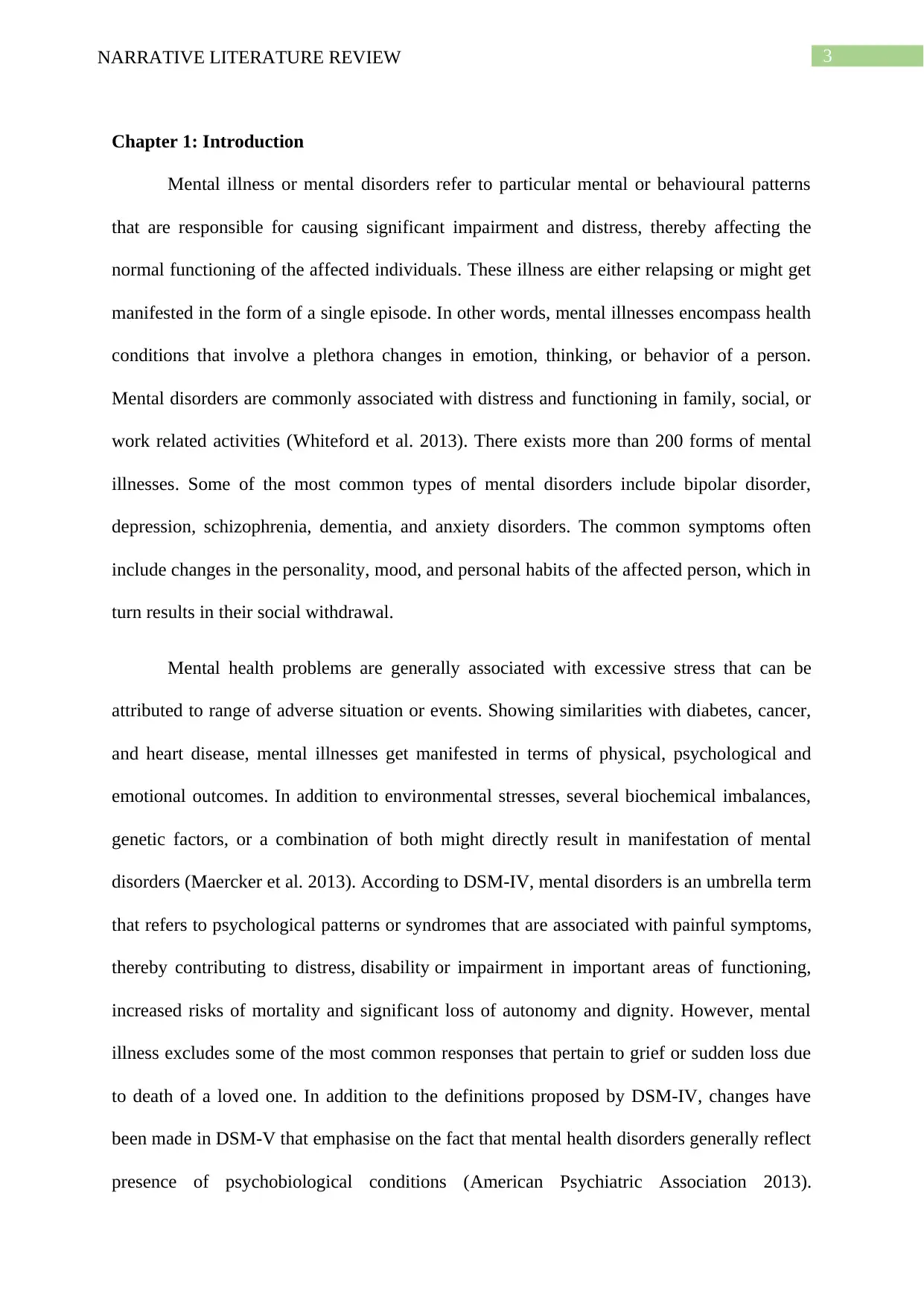
3NARRATIVE LITERATURE REVIEW
Chapter 1: Introduction
Mental illness or mental disorders refer to particular mental or behavioural patterns
that are responsible for causing significant impairment and distress, thereby affecting the
normal functioning of the affected individuals. These illness are either relapsing or might get
manifested in the form of a single episode. In other words, mental illnesses encompass health
conditions that involve a plethora changes in emotion, thinking, or behavior of a person.
Mental disorders are commonly associated with distress and functioning in family, social, or
work related activities (Whiteford et al. 2013). There exists more than 200 forms of mental
illnesses. Some of the most common types of mental disorders include bipolar disorder,
depression, schizophrenia, dementia, and anxiety disorders. The common symptoms often
include changes in the personality, mood, and personal habits of the affected person, which in
turn results in their social withdrawal.
Mental health problems are generally associated with excessive stress that can be
attributed to range of adverse situation or events. Showing similarities with diabetes, cancer,
and heart disease, mental illnesses get manifested in terms of physical, psychological and
emotional outcomes. In addition to environmental stresses, several biochemical imbalances,
genetic factors, or a combination of both might directly result in manifestation of mental
disorders (Maercker et al. 2013). According to DSM-IV, mental disorders is an umbrella term
that refers to psychological patterns or syndromes that are associated with painful symptoms,
thereby contributing to distress, disability or impairment in important areas of functioning,
increased risks of mortality and significant loss of autonomy and dignity. However, mental
illness excludes some of the most common responses that pertain to grief or sudden loss due
to death of a loved one. In addition to the definitions proposed by DSM-IV, changes have
been made in DSM-V that emphasise on the fact that mental health disorders generally reflect
presence of psychobiological conditions (American Psychiatric Association 2013).
Chapter 1: Introduction
Mental illness or mental disorders refer to particular mental or behavioural patterns
that are responsible for causing significant impairment and distress, thereby affecting the
normal functioning of the affected individuals. These illness are either relapsing or might get
manifested in the form of a single episode. In other words, mental illnesses encompass health
conditions that involve a plethora changes in emotion, thinking, or behavior of a person.
Mental disorders are commonly associated with distress and functioning in family, social, or
work related activities (Whiteford et al. 2013). There exists more than 200 forms of mental
illnesses. Some of the most common types of mental disorders include bipolar disorder,
depression, schizophrenia, dementia, and anxiety disorders. The common symptoms often
include changes in the personality, mood, and personal habits of the affected person, which in
turn results in their social withdrawal.
Mental health problems are generally associated with excessive stress that can be
attributed to range of adverse situation or events. Showing similarities with diabetes, cancer,
and heart disease, mental illnesses get manifested in terms of physical, psychological and
emotional outcomes. In addition to environmental stresses, several biochemical imbalances,
genetic factors, or a combination of both might directly result in manifestation of mental
disorders (Maercker et al. 2013). According to DSM-IV, mental disorders is an umbrella term
that refers to psychological patterns or syndromes that are associated with painful symptoms,
thereby contributing to distress, disability or impairment in important areas of functioning,
increased risks of mortality and significant loss of autonomy and dignity. However, mental
illness excludes some of the most common responses that pertain to grief or sudden loss due
to death of a loved one. In addition to the definitions proposed by DSM-IV, changes have
been made in DSM-V that emphasise on the fact that mental health disorders generally reflect
presence of psychobiological conditions (American Psychiatric Association 2013).
Paraphrase This Document
Need a fresh take? Get an instant paraphrase of this document with our AI Paraphraser
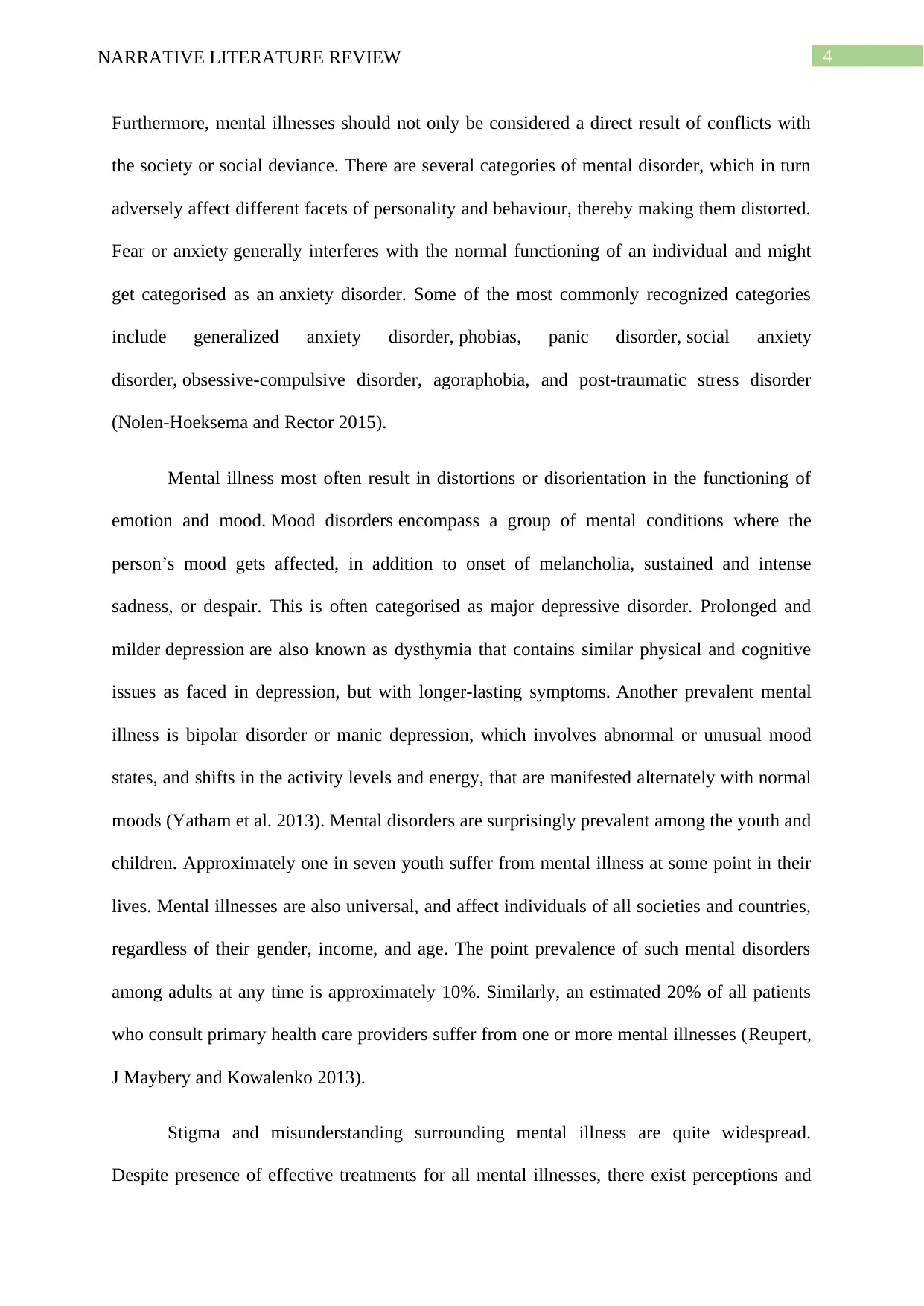
4NARRATIVE LITERATURE REVIEW
Furthermore, mental illnesses should not only be considered a direct result of conflicts with
the society or social deviance. There are several categories of mental disorder, which in turn
adversely affect different facets of personality and behaviour, thereby making them distorted.
Fear or anxiety generally interferes with the normal functioning of an individual and might
get categorised as an anxiety disorder. Some of the most commonly recognized categories
include generalized anxiety disorder, phobias, panic disorder, social anxiety
disorder, obsessive-compulsive disorder, agoraphobia, and post-traumatic stress disorder
(Nolen-Hoeksema and Rector 2015).
Mental illness most often result in distortions or disorientation in the functioning of
emotion and mood. Mood disorders encompass a group of mental conditions where the
person’s mood gets affected, in addition to onset of melancholia, sustained and intense
sadness, or despair. This is often categorised as major depressive disorder. Prolonged and
milder depression are also known as dysthymia that contains similar physical and cognitive
issues as faced in depression, but with longer-lasting symptoms. Another prevalent mental
illness is bipolar disorder or manic depression, which involves abnormal or unusual mood
states, and shifts in the activity levels and energy, that are manifested alternately with normal
moods (Yatham et al. 2013). Mental disorders are surprisingly prevalent among the youth and
children. Approximately one in seven youth suffer from mental illness at some point in their
lives. Mental illnesses are also universal, and affect individuals of all societies and countries,
regardless of their gender, income, and age. The point prevalence of such mental disorders
among adults at any time is approximately 10%. Similarly, an estimated 20% of all patients
who consult primary health care providers suffer from one or more mental illnesses (Reupert,
J Maybery and Kowalenko 2013).
Stigma and misunderstanding surrounding mental illness are quite widespread.
Despite presence of effective treatments for all mental illnesses, there exist perceptions and
Furthermore, mental illnesses should not only be considered a direct result of conflicts with
the society or social deviance. There are several categories of mental disorder, which in turn
adversely affect different facets of personality and behaviour, thereby making them distorted.
Fear or anxiety generally interferes with the normal functioning of an individual and might
get categorised as an anxiety disorder. Some of the most commonly recognized categories
include generalized anxiety disorder, phobias, panic disorder, social anxiety
disorder, obsessive-compulsive disorder, agoraphobia, and post-traumatic stress disorder
(Nolen-Hoeksema and Rector 2015).
Mental illness most often result in distortions or disorientation in the functioning of
emotion and mood. Mood disorders encompass a group of mental conditions where the
person’s mood gets affected, in addition to onset of melancholia, sustained and intense
sadness, or despair. This is often categorised as major depressive disorder. Prolonged and
milder depression are also known as dysthymia that contains similar physical and cognitive
issues as faced in depression, but with longer-lasting symptoms. Another prevalent mental
illness is bipolar disorder or manic depression, which involves abnormal or unusual mood
states, and shifts in the activity levels and energy, that are manifested alternately with normal
moods (Yatham et al. 2013). Mental disorders are surprisingly prevalent among the youth and
children. Approximately one in seven youth suffer from mental illness at some point in their
lives. Mental illnesses are also universal, and affect individuals of all societies and countries,
regardless of their gender, income, and age. The point prevalence of such mental disorders
among adults at any time is approximately 10%. Similarly, an estimated 20% of all patients
who consult primary health care providers suffer from one or more mental illnesses (Reupert,
J Maybery and Kowalenko 2013).
Stigma and misunderstanding surrounding mental illness are quite widespread.
Despite presence of effective treatments for all mental illnesses, there exist perceptions and
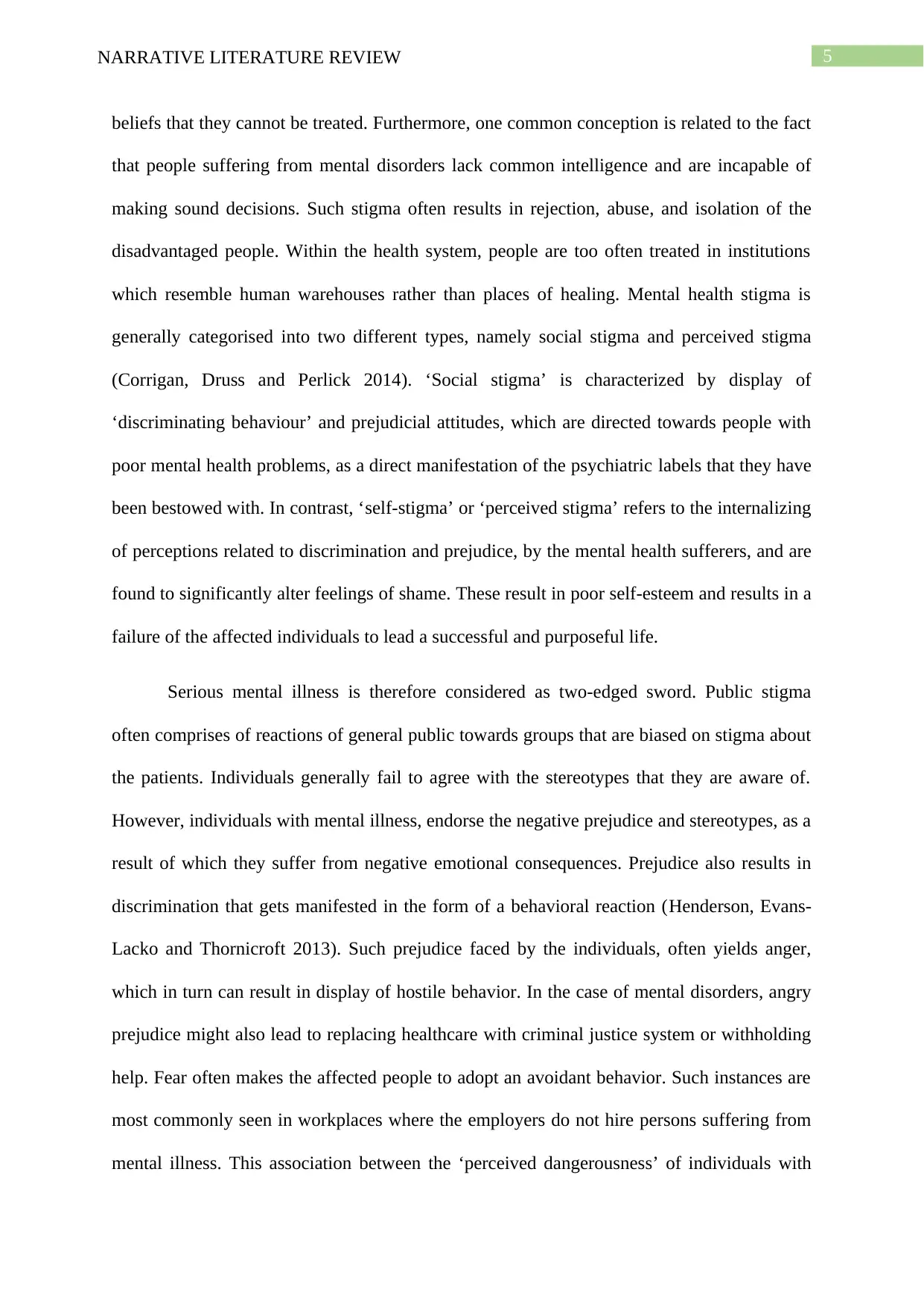
5NARRATIVE LITERATURE REVIEW
beliefs that they cannot be treated. Furthermore, one common conception is related to the fact
that people suffering from mental disorders lack common intelligence and are incapable of
making sound decisions. Such stigma often results in rejection, abuse, and isolation of the
disadvantaged people. Within the health system, people are too often treated in institutions
which resemble human warehouses rather than places of healing. Mental health stigma is
generally categorised into two different types, namely social stigma and perceived stigma
(Corrigan, Druss and Perlick 2014). ‘Social stigma’ is characterized by display of
‘discriminating behaviour’ and prejudicial attitudes, which are directed towards people with
poor mental health problems, as a direct manifestation of the psychiatric labels that they have
been bestowed with. In contrast, ‘self-stigma’ or ‘perceived stigma’ refers to the internalizing
of perceptions related to discrimination and prejudice, by the mental health sufferers, and are
found to significantly alter feelings of shame. These result in poor self-esteem and results in a
failure of the affected individuals to lead a successful and purposeful life.
Serious mental illness is therefore considered as two-edged sword. Public stigma
often comprises of reactions of general public towards groups that are biased on stigma about
the patients. Individuals generally fail to agree with the stereotypes that they are aware of.
However, individuals with mental illness, endorse the negative prejudice and stereotypes, as a
result of which they suffer from negative emotional consequences. Prejudice also results in
discrimination that gets manifested in the form of a behavioral reaction (Henderson, Evans-
Lacko and Thornicroft 2013). Such prejudice faced by the individuals, often yields anger,
which in turn can result in display of hostile behavior. In the case of mental disorders, angry
prejudice might also lead to replacing healthcare with criminal justice system or withholding
help. Fear often makes the affected people to adopt an avoidant behavior. Such instances are
most commonly seen in workplaces where the employers do not hire persons suffering from
mental illness. This association between the ‘perceived dangerousness’ of individuals with
beliefs that they cannot be treated. Furthermore, one common conception is related to the fact
that people suffering from mental disorders lack common intelligence and are incapable of
making sound decisions. Such stigma often results in rejection, abuse, and isolation of the
disadvantaged people. Within the health system, people are too often treated in institutions
which resemble human warehouses rather than places of healing. Mental health stigma is
generally categorised into two different types, namely social stigma and perceived stigma
(Corrigan, Druss and Perlick 2014). ‘Social stigma’ is characterized by display of
‘discriminating behaviour’ and prejudicial attitudes, which are directed towards people with
poor mental health problems, as a direct manifestation of the psychiatric labels that they have
been bestowed with. In contrast, ‘self-stigma’ or ‘perceived stigma’ refers to the internalizing
of perceptions related to discrimination and prejudice, by the mental health sufferers, and are
found to significantly alter feelings of shame. These result in poor self-esteem and results in a
failure of the affected individuals to lead a successful and purposeful life.
Serious mental illness is therefore considered as two-edged sword. Public stigma
often comprises of reactions of general public towards groups that are biased on stigma about
the patients. Individuals generally fail to agree with the stereotypes that they are aware of.
However, individuals with mental illness, endorse the negative prejudice and stereotypes, as a
result of which they suffer from negative emotional consequences. Prejudice also results in
discrimination that gets manifested in the form of a behavioral reaction (Henderson, Evans-
Lacko and Thornicroft 2013). Such prejudice faced by the individuals, often yields anger,
which in turn can result in display of hostile behavior. In the case of mental disorders, angry
prejudice might also lead to replacing healthcare with criminal justice system or withholding
help. Fear often makes the affected people to adopt an avoidant behavior. Such instances are
most commonly seen in workplaces where the employers do not hire persons suffering from
mental illness. This association between the ‘perceived dangerousness’ of individuals with
⊘ This is a preview!⊘
Do you want full access?
Subscribe today to unlock all pages.

Trusted by 1+ million students worldwide
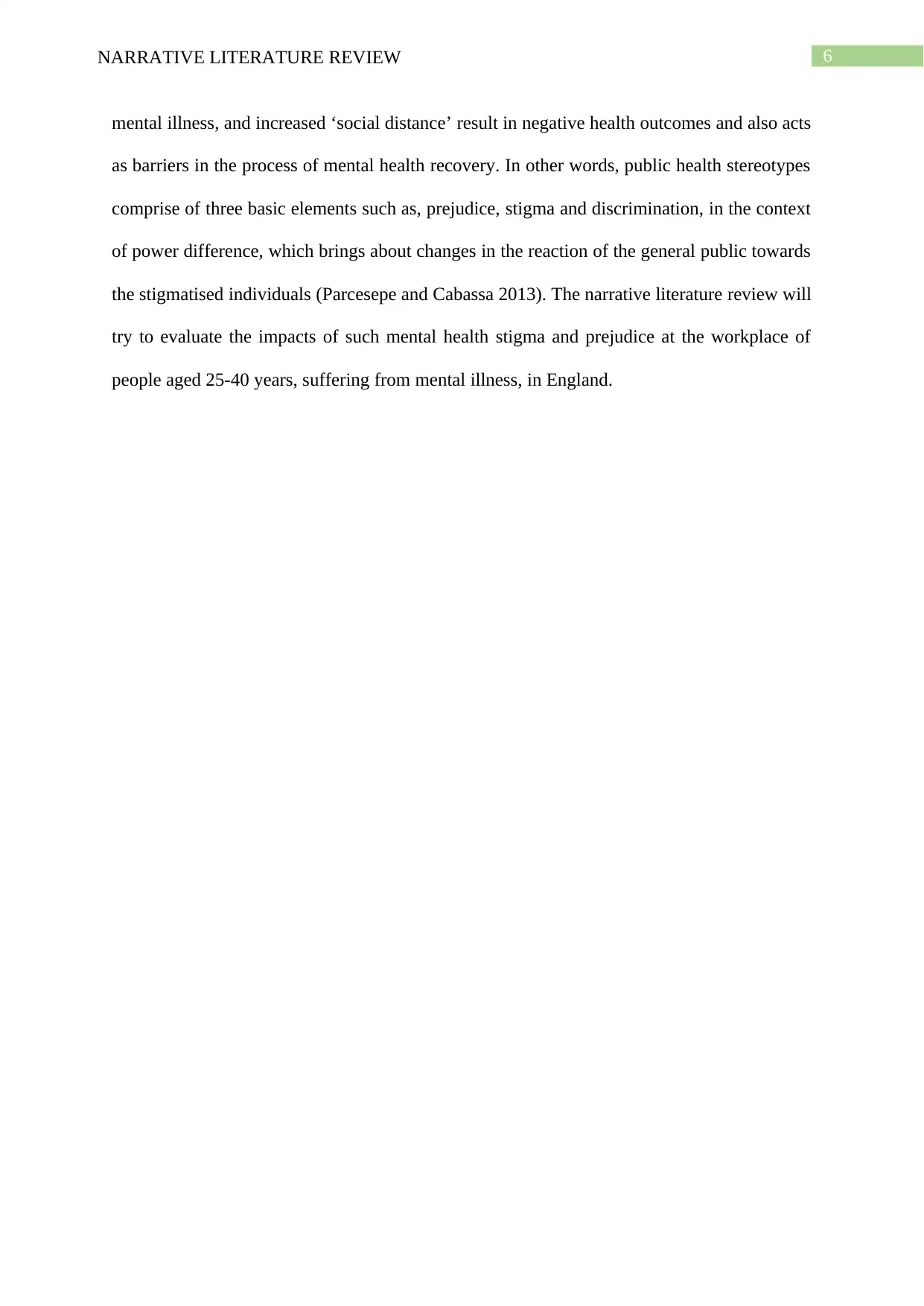
6NARRATIVE LITERATURE REVIEW
mental illness, and increased ‘social distance’ result in negative health outcomes and also acts
as barriers in the process of mental health recovery. In other words, public health stereotypes
comprise of three basic elements such as, prejudice, stigma and discrimination, in the context
of power difference, which brings about changes in the reaction of the general public towards
the stigmatised individuals (Parcesepe and Cabassa 2013). The narrative literature review will
try to evaluate the impacts of such mental health stigma and prejudice at the workplace of
people aged 25-40 years, suffering from mental illness, in England.
mental illness, and increased ‘social distance’ result in negative health outcomes and also acts
as barriers in the process of mental health recovery. In other words, public health stereotypes
comprise of three basic elements such as, prejudice, stigma and discrimination, in the context
of power difference, which brings about changes in the reaction of the general public towards
the stigmatised individuals (Parcesepe and Cabassa 2013). The narrative literature review will
try to evaluate the impacts of such mental health stigma and prejudice at the workplace of
people aged 25-40 years, suffering from mental illness, in England.
Paraphrase This Document
Need a fresh take? Get an instant paraphrase of this document with our AI Paraphraser
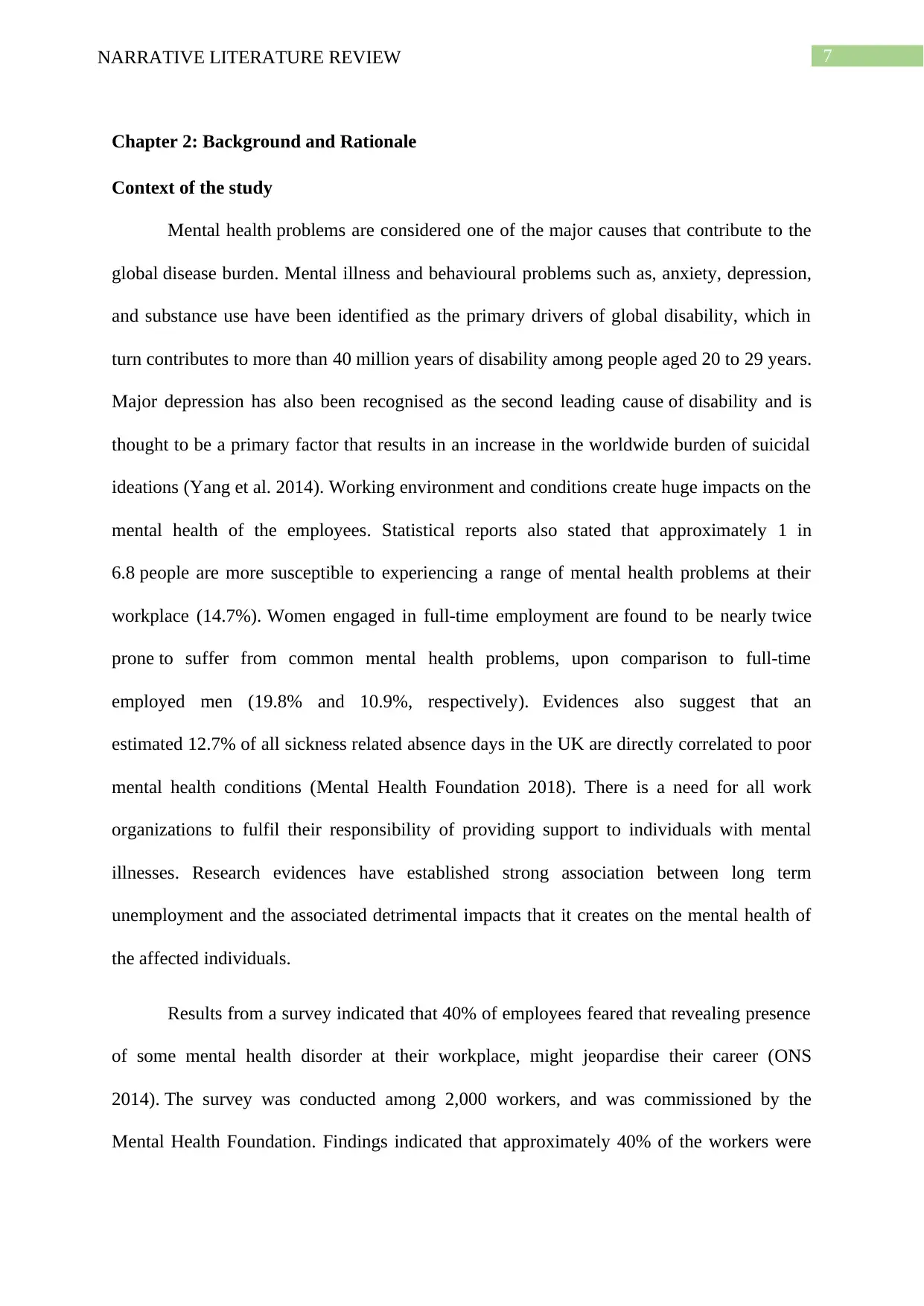
7NARRATIVE LITERATURE REVIEW
Chapter 2: Background and Rationale
Context of the study
Mental health problems are considered one of the major causes that contribute to the
global disease burden. Mental illness and behavioural problems such as, anxiety, depression,
and substance use have been identified as the primary drivers of global disability, which in
turn contributes to more than 40 million years of disability among people aged 20 to 29 years.
Major depression has also been recognised as the second leading cause of disability and is
thought to be a primary factor that results in an increase in the worldwide burden of suicidal
ideations (Yang et al. 2014). Working environment and conditions create huge impacts on the
mental health of the employees. Statistical reports also stated that approximately 1 in
6.8 people are more susceptible to experiencing a range of mental health problems at their
workplace (14.7%). Women engaged in full-time employment are found to be nearly twice
prone to suffer from common mental health problems, upon comparison to full-time
employed men (19.8% and 10.9%, respectively). Evidences also suggest that an
estimated 12.7% of all sickness related absence days in the UK are directly correlated to poor
mental health conditions (Mental Health Foundation 2018). There is a need for all work
organizations to fulfil their responsibility of providing support to individuals with mental
illnesses. Research evidences have established strong association between long term
unemployment and the associated detrimental impacts that it creates on the mental health of
the affected individuals.
Results from a survey indicated that 40% of employees feared that revealing presence
of some mental health disorder at their workplace, might jeopardise their career (ONS
2014). The survey was conducted among 2,000 workers, and was commissioned by the
Mental Health Foundation. Findings indicated that approximately 40% of the workers were
Chapter 2: Background and Rationale
Context of the study
Mental health problems are considered one of the major causes that contribute to the
global disease burden. Mental illness and behavioural problems such as, anxiety, depression,
and substance use have been identified as the primary drivers of global disability, which in
turn contributes to more than 40 million years of disability among people aged 20 to 29 years.
Major depression has also been recognised as the second leading cause of disability and is
thought to be a primary factor that results in an increase in the worldwide burden of suicidal
ideations (Yang et al. 2014). Working environment and conditions create huge impacts on the
mental health of the employees. Statistical reports also stated that approximately 1 in
6.8 people are more susceptible to experiencing a range of mental health problems at their
workplace (14.7%). Women engaged in full-time employment are found to be nearly twice
prone to suffer from common mental health problems, upon comparison to full-time
employed men (19.8% and 10.9%, respectively). Evidences also suggest that an
estimated 12.7% of all sickness related absence days in the UK are directly correlated to poor
mental health conditions (Mental Health Foundation 2018). There is a need for all work
organizations to fulfil their responsibility of providing support to individuals with mental
illnesses. Research evidences have established strong association between long term
unemployment and the associated detrimental impacts that it creates on the mental health of
the affected individuals.
Results from a survey indicated that 40% of employees feared that revealing presence
of some mental health disorder at their workplace, might jeopardise their career (ONS
2014). The survey was conducted among 2,000 workers, and was commissioned by the
Mental Health Foundation. Findings indicated that approximately 40% of the workers were
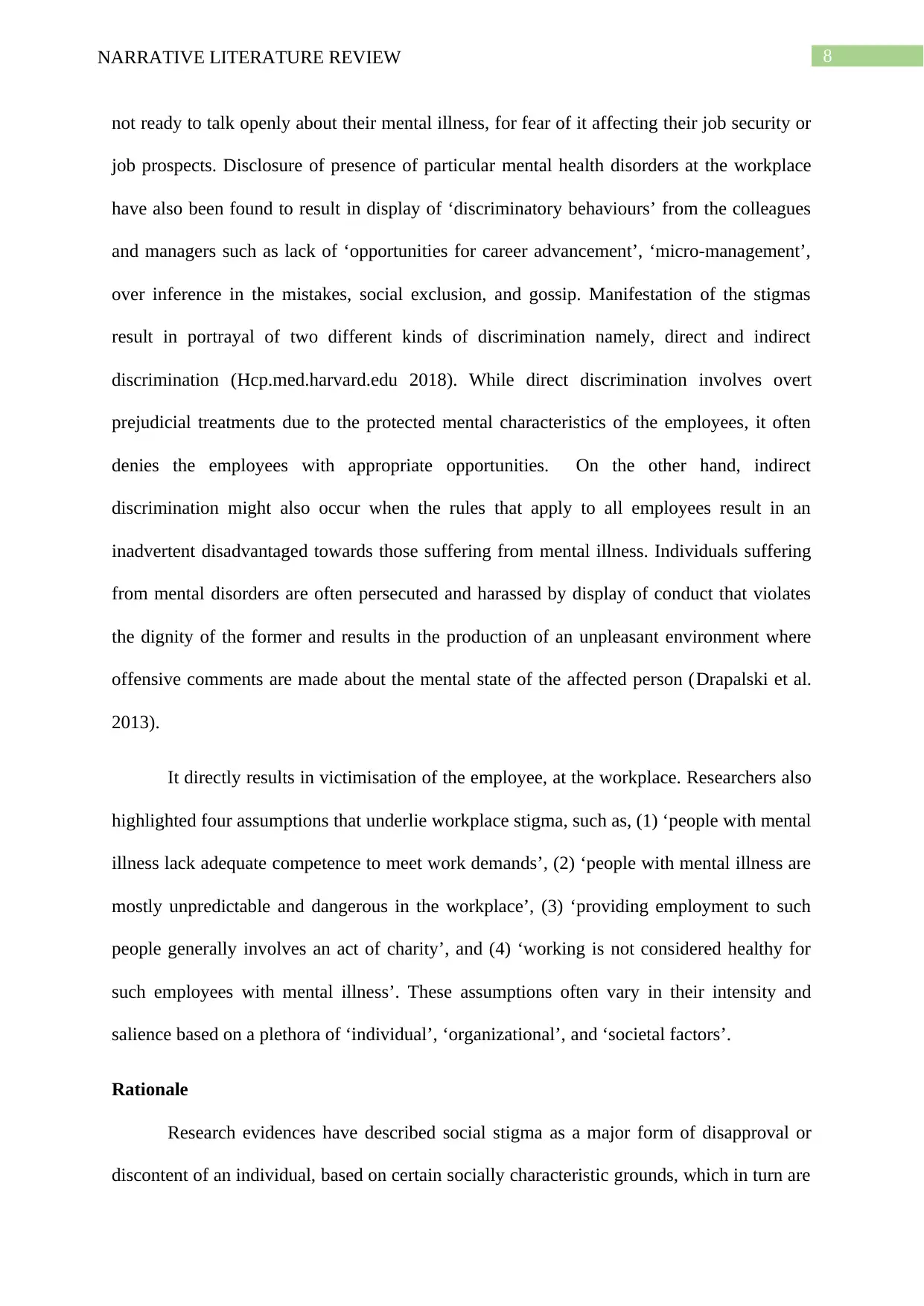
8NARRATIVE LITERATURE REVIEW
not ready to talk openly about their mental illness, for fear of it affecting their job security or
job prospects. Disclosure of presence of particular mental health disorders at the workplace
have also been found to result in display of ‘discriminatory behaviours’ from the colleagues
and managers such as lack of ‘opportunities for career advancement’, ‘micro-management’,
over inference in the mistakes, social exclusion, and gossip. Manifestation of the stigmas
result in portrayal of two different kinds of discrimination namely, direct and indirect
discrimination (Hcp.med.harvard.edu 2018). While direct discrimination involves overt
prejudicial treatments due to the protected mental characteristics of the employees, it often
denies the employees with appropriate opportunities. On the other hand, indirect
discrimination might also occur when the rules that apply to all employees result in an
inadvertent disadvantaged towards those suffering from mental illness. Individuals suffering
from mental disorders are often persecuted and harassed by display of conduct that violates
the dignity of the former and results in the production of an unpleasant environment where
offensive comments are made about the mental state of the affected person (Drapalski et al.
2013).
It directly results in victimisation of the employee, at the workplace. Researchers also
highlighted four assumptions that underlie workplace stigma, such as, (1) ‘people with mental
illness lack adequate competence to meet work demands’, (2) ‘people with mental illness are
mostly unpredictable and dangerous in the workplace’, (3) ‘providing employment to such
people generally involves an act of charity’, and (4) ‘working is not considered healthy for
such employees with mental illness’. These assumptions often vary in their intensity and
salience based on a plethora of ‘individual’, ‘organizational’, and ‘societal factors’.
Rationale
Research evidences have described social stigma as a major form of disapproval or
discontent of an individual, based on certain socially characteristic grounds, which in turn are
not ready to talk openly about their mental illness, for fear of it affecting their job security or
job prospects. Disclosure of presence of particular mental health disorders at the workplace
have also been found to result in display of ‘discriminatory behaviours’ from the colleagues
and managers such as lack of ‘opportunities for career advancement’, ‘micro-management’,
over inference in the mistakes, social exclusion, and gossip. Manifestation of the stigmas
result in portrayal of two different kinds of discrimination namely, direct and indirect
discrimination (Hcp.med.harvard.edu 2018). While direct discrimination involves overt
prejudicial treatments due to the protected mental characteristics of the employees, it often
denies the employees with appropriate opportunities. On the other hand, indirect
discrimination might also occur when the rules that apply to all employees result in an
inadvertent disadvantaged towards those suffering from mental illness. Individuals suffering
from mental disorders are often persecuted and harassed by display of conduct that violates
the dignity of the former and results in the production of an unpleasant environment where
offensive comments are made about the mental state of the affected person (Drapalski et al.
2013).
It directly results in victimisation of the employee, at the workplace. Researchers also
highlighted four assumptions that underlie workplace stigma, such as, (1) ‘people with mental
illness lack adequate competence to meet work demands’, (2) ‘people with mental illness are
mostly unpredictable and dangerous in the workplace’, (3) ‘providing employment to such
people generally involves an act of charity’, and (4) ‘working is not considered healthy for
such employees with mental illness’. These assumptions often vary in their intensity and
salience based on a plethora of ‘individual’, ‘organizational’, and ‘societal factors’.
Rationale
Research evidences have described social stigma as a major form of disapproval or
discontent of an individual, based on certain socially characteristic grounds, which in turn are
⊘ This is a preview!⊘
Do you want full access?
Subscribe today to unlock all pages.

Trusted by 1+ million students worldwide
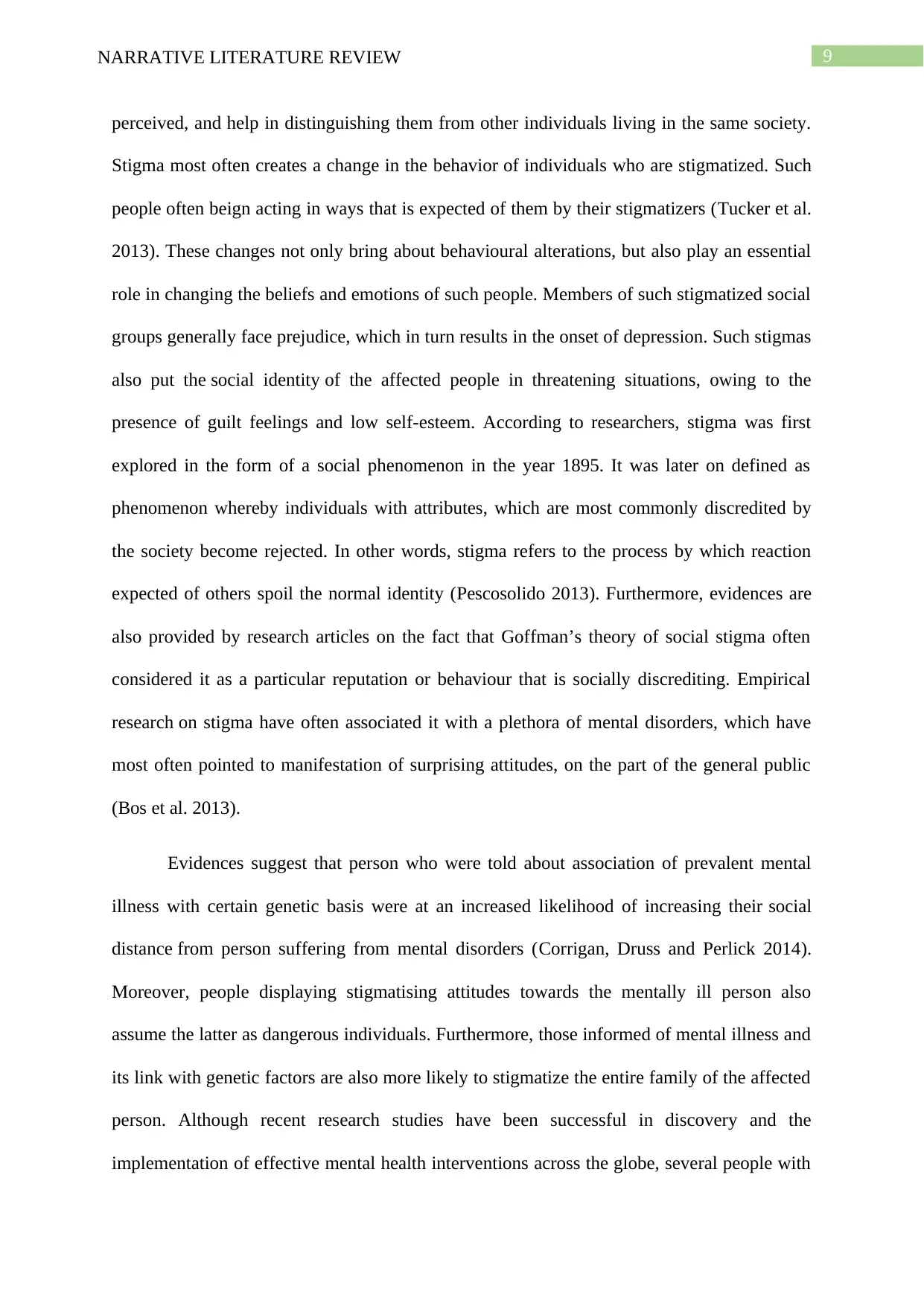
9NARRATIVE LITERATURE REVIEW
perceived, and help in distinguishing them from other individuals living in the same society.
Stigma most often creates a change in the behavior of individuals who are stigmatized. Such
people often beign acting in ways that is expected of them by their stigmatizers (Tucker et al.
2013). These changes not only bring about behavioural alterations, but also play an essential
role in changing the beliefs and emotions of such people. Members of such stigmatized social
groups generally face prejudice, which in turn results in the onset of depression. Such stigmas
also put the social identity of the affected people in threatening situations, owing to the
presence of guilt feelings and low self-esteem. According to researchers, stigma was first
explored in the form of a social phenomenon in the year 1895. It was later on defined as
phenomenon whereby individuals with attributes, which are most commonly discredited by
the society become rejected. In other words, stigma refers to the process by which reaction
expected of others spoil the normal identity (Pescosolido 2013). Furthermore, evidences are
also provided by research articles on the fact that Goffman’s theory of social stigma often
considered it as a particular reputation or behaviour that is socially discrediting. Empirical
research on stigma have often associated it with a plethora of mental disorders, which have
most often pointed to manifestation of surprising attitudes, on the part of the general public
(Bos et al. 2013).
Evidences suggest that person who were told about association of prevalent mental
illness with certain genetic basis were at an increased likelihood of increasing their social
distance from person suffering from mental disorders (Corrigan, Druss and Perlick 2014).
Moreover, people displaying stigmatising attitudes towards the mentally ill person also
assume the latter as dangerous individuals. Furthermore, those informed of mental illness and
its link with genetic factors are also more likely to stigmatize the entire family of the affected
person. Although recent research studies have been successful in discovery and the
implementation of effective mental health interventions across the globe, several people with
perceived, and help in distinguishing them from other individuals living in the same society.
Stigma most often creates a change in the behavior of individuals who are stigmatized. Such
people often beign acting in ways that is expected of them by their stigmatizers (Tucker et al.
2013). These changes not only bring about behavioural alterations, but also play an essential
role in changing the beliefs and emotions of such people. Members of such stigmatized social
groups generally face prejudice, which in turn results in the onset of depression. Such stigmas
also put the social identity of the affected people in threatening situations, owing to the
presence of guilt feelings and low self-esteem. According to researchers, stigma was first
explored in the form of a social phenomenon in the year 1895. It was later on defined as
phenomenon whereby individuals with attributes, which are most commonly discredited by
the society become rejected. In other words, stigma refers to the process by which reaction
expected of others spoil the normal identity (Pescosolido 2013). Furthermore, evidences are
also provided by research articles on the fact that Goffman’s theory of social stigma often
considered it as a particular reputation or behaviour that is socially discrediting. Empirical
research on stigma have often associated it with a plethora of mental disorders, which have
most often pointed to manifestation of surprising attitudes, on the part of the general public
(Bos et al. 2013).
Evidences suggest that person who were told about association of prevalent mental
illness with certain genetic basis were at an increased likelihood of increasing their social
distance from person suffering from mental disorders (Corrigan, Druss and Perlick 2014).
Moreover, people displaying stigmatising attitudes towards the mentally ill person also
assume the latter as dangerous individuals. Furthermore, those informed of mental illness and
its link with genetic factors are also more likely to stigmatize the entire family of the affected
person. Although recent research studies have been successful in discovery and the
implementation of effective mental health interventions across the globe, several people with
Paraphrase This Document
Need a fresh take? Get an instant paraphrase of this document with our AI Paraphraser
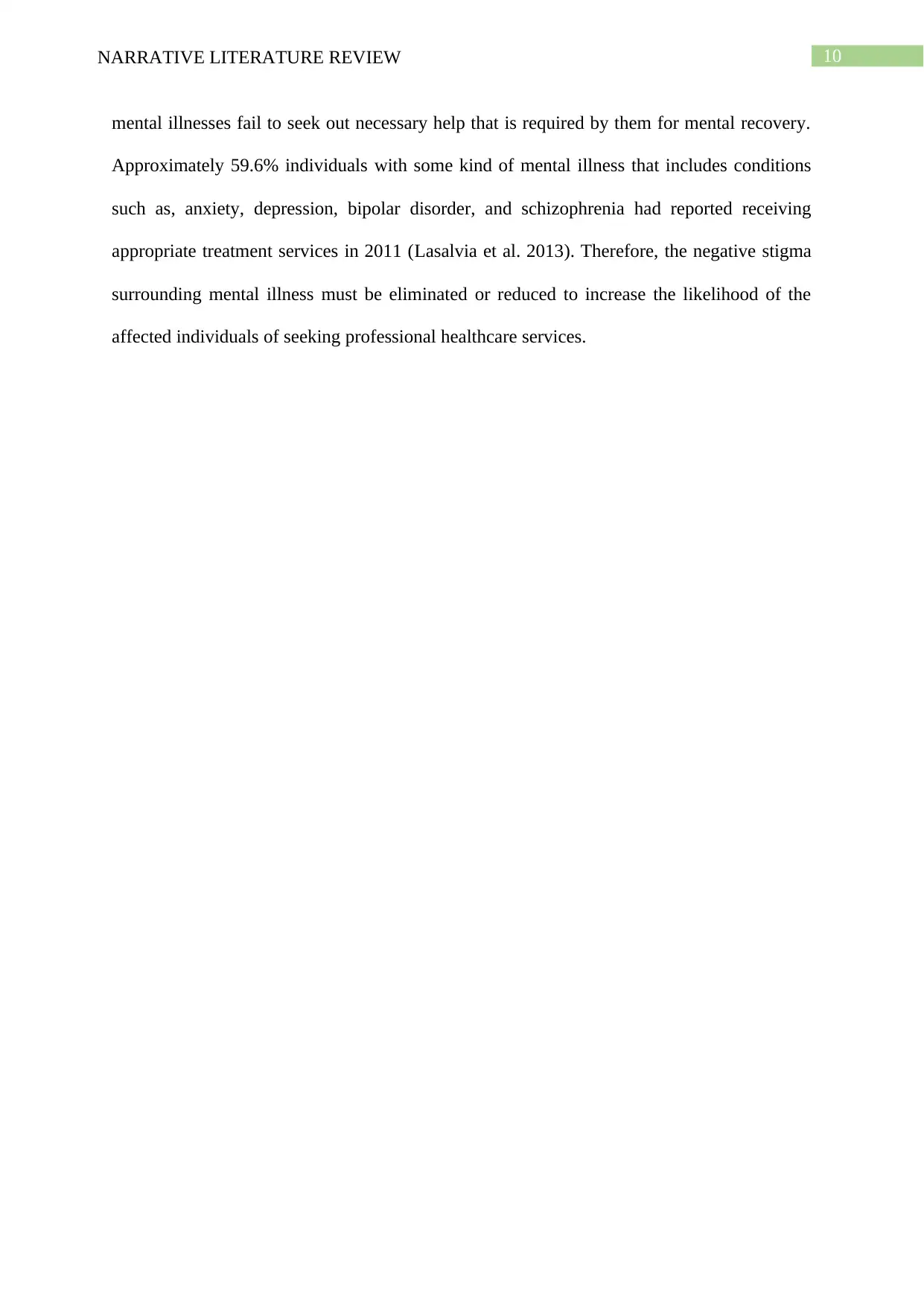
10NARRATIVE LITERATURE REVIEW
mental illnesses fail to seek out necessary help that is required by them for mental recovery.
Approximately 59.6% individuals with some kind of mental illness that includes conditions
such as, anxiety, depression, bipolar disorder, and schizophrenia had reported receiving
appropriate treatment services in 2011 (Lasalvia et al. 2013). Therefore, the negative stigma
surrounding mental illness must be eliminated or reduced to increase the likelihood of the
affected individuals of seeking professional healthcare services.
mental illnesses fail to seek out necessary help that is required by them for mental recovery.
Approximately 59.6% individuals with some kind of mental illness that includes conditions
such as, anxiety, depression, bipolar disorder, and schizophrenia had reported receiving
appropriate treatment services in 2011 (Lasalvia et al. 2013). Therefore, the negative stigma
surrounding mental illness must be eliminated or reduced to increase the likelihood of the
affected individuals of seeking professional healthcare services.
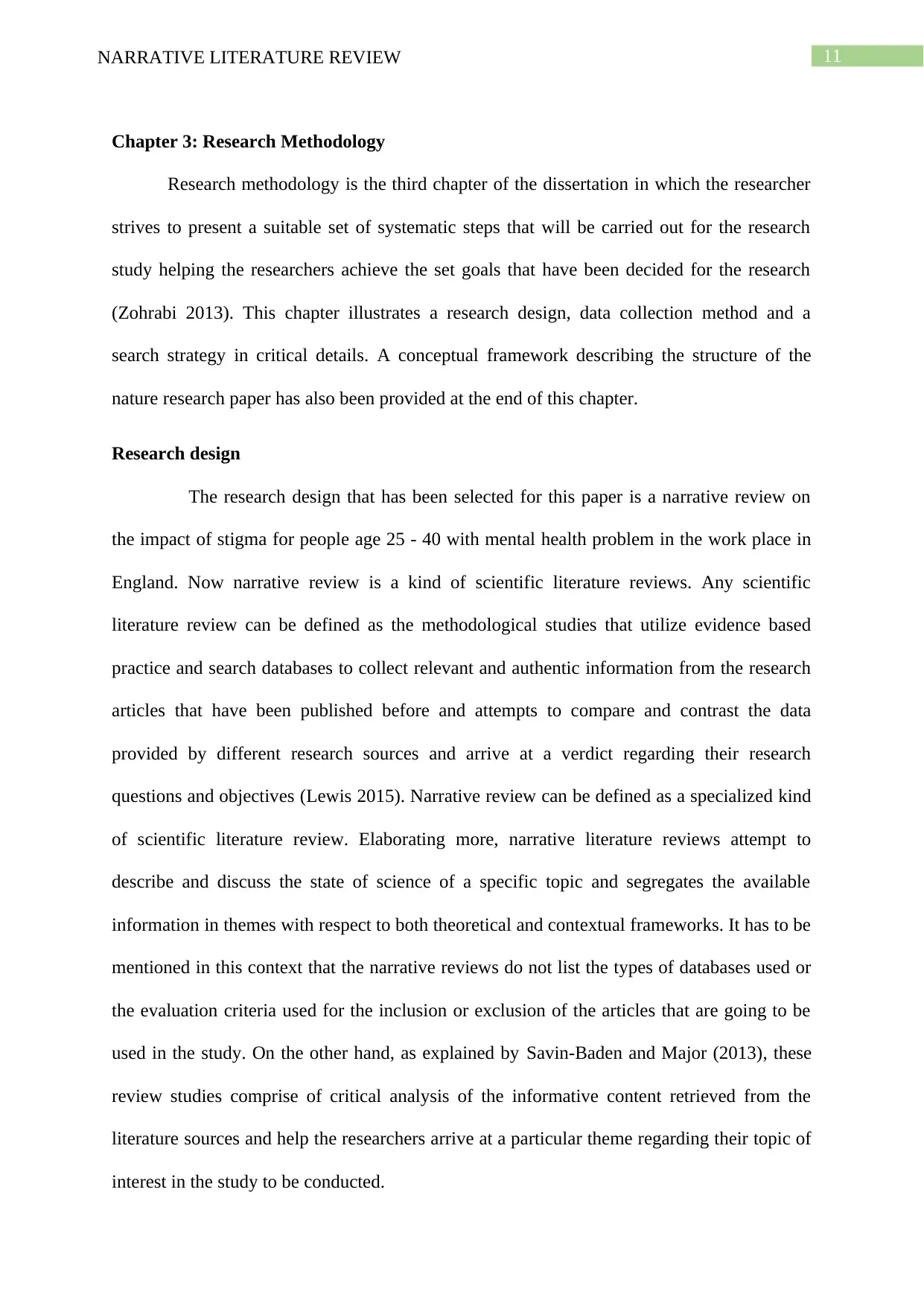
11NARRATIVE LITERATURE REVIEW
Chapter 3: Research Methodology
Research methodology is the third chapter of the dissertation in which the researcher
strives to present a suitable set of systematic steps that will be carried out for the research
study helping the researchers achieve the set goals that have been decided for the research
(Zohrabi 2013). This chapter illustrates a research design, data collection method and a
search strategy in critical details. A conceptual framework describing the structure of the
nature research paper has also been provided at the end of this chapter.
Research design
The research design that has been selected for this paper is a narrative review on
the impact of stigma for people age 25 - 40 with mental health problem in the work place in
England. Now narrative review is a kind of scientific literature reviews. Any scientific
literature review can be defined as the methodological studies that utilize evidence based
practice and search databases to collect relevant and authentic information from the research
articles that have been published before and attempts to compare and contrast the data
provided by different research sources and arrive at a verdict regarding their research
questions and objectives (Lewis 2015). Narrative review can be defined as a specialized kind
of scientific literature review. Elaborating more, narrative literature reviews attempt to
describe and discuss the state of science of a specific topic and segregates the available
information in themes with respect to both theoretical and contextual frameworks. It has to be
mentioned in this context that the narrative reviews do not list the types of databases used or
the evaluation criteria used for the inclusion or exclusion of the articles that are going to be
used in the study. On the other hand, as explained by Savin-Baden and Major (2013), these
review studies comprise of critical analysis of the informative content retrieved from the
literature sources and help the researchers arrive at a particular theme regarding their topic of
interest in the study to be conducted.
Chapter 3: Research Methodology
Research methodology is the third chapter of the dissertation in which the researcher
strives to present a suitable set of systematic steps that will be carried out for the research
study helping the researchers achieve the set goals that have been decided for the research
(Zohrabi 2013). This chapter illustrates a research design, data collection method and a
search strategy in critical details. A conceptual framework describing the structure of the
nature research paper has also been provided at the end of this chapter.
Research design
The research design that has been selected for this paper is a narrative review on
the impact of stigma for people age 25 - 40 with mental health problem in the work place in
England. Now narrative review is a kind of scientific literature reviews. Any scientific
literature review can be defined as the methodological studies that utilize evidence based
practice and search databases to collect relevant and authentic information from the research
articles that have been published before and attempts to compare and contrast the data
provided by different research sources and arrive at a verdict regarding their research
questions and objectives (Lewis 2015). Narrative review can be defined as a specialized kind
of scientific literature review. Elaborating more, narrative literature reviews attempt to
describe and discuss the state of science of a specific topic and segregates the available
information in themes with respect to both theoretical and contextual frameworks. It has to be
mentioned in this context that the narrative reviews do not list the types of databases used or
the evaluation criteria used for the inclusion or exclusion of the articles that are going to be
used in the study. On the other hand, as explained by Savin-Baden and Major (2013), these
review studies comprise of critical analysis of the informative content retrieved from the
literature sources and help the researchers arrive at a particular theme regarding their topic of
interest in the study to be conducted.
⊘ This is a preview!⊘
Do you want full access?
Subscribe today to unlock all pages.

Trusted by 1+ million students worldwide
1 out of 38
Related Documents
Your All-in-One AI-Powered Toolkit for Academic Success.
+13062052269
info@desklib.com
Available 24*7 on WhatsApp / Email
![[object Object]](/_next/static/media/star-bottom.7253800d.svg)
Unlock your academic potential
Copyright © 2020–2025 A2Z Services. All Rights Reserved. Developed and managed by ZUCOL.





